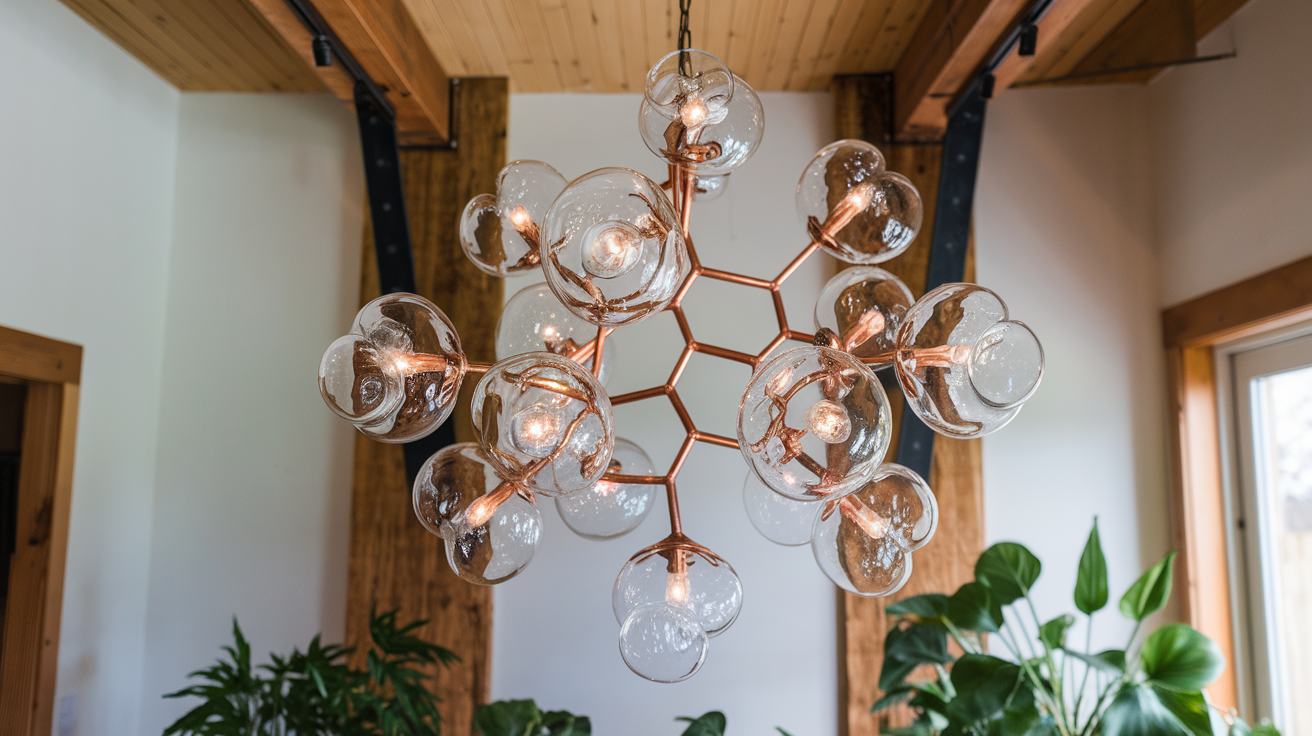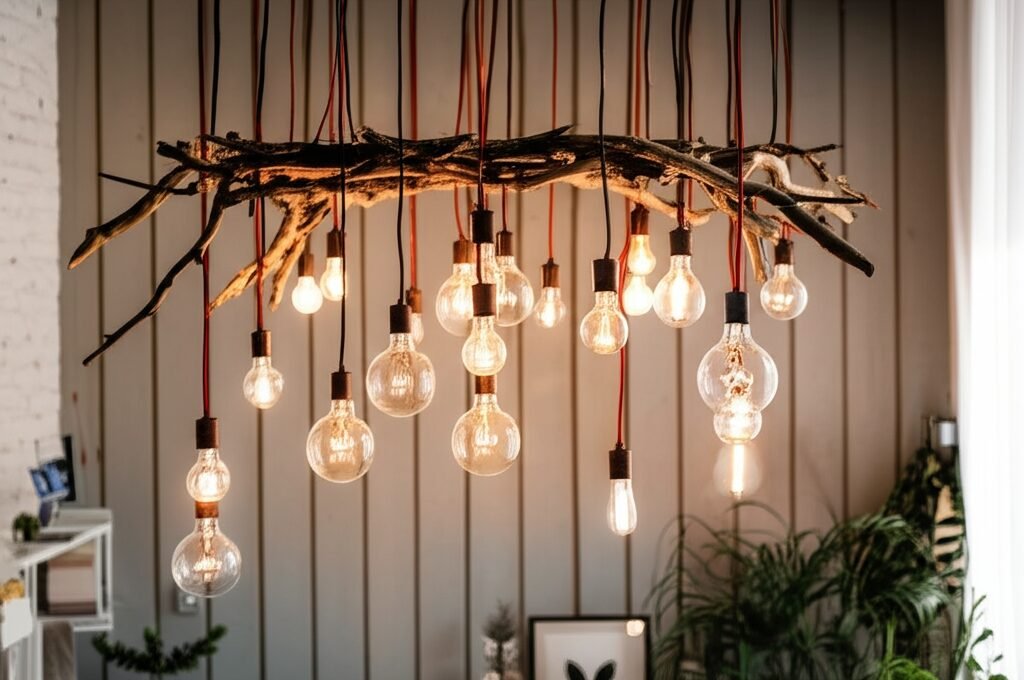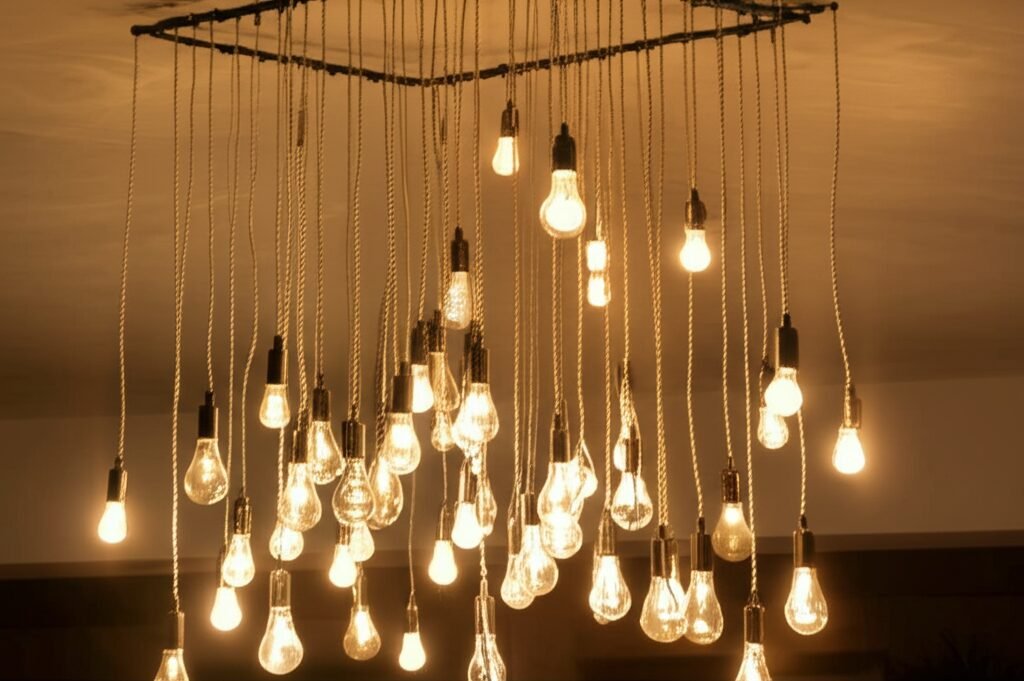Key Takeaways:
- What are they? Branch chandeliers are light fixtures designed to look like tree branches, bringing a natural, organic feel indoors.
- Styles Vary: You can find them in rustic, modern, minimalist, and even luxurious crystal branch chandelier styles.
- Where to Use? They work great in dining rooms, living rooms, entryways, and bedrooms – anywhere you want a statement piece. Consider room size and ceiling height.
- Choosing Tips: Match the chandelier’s scale to your room, consider the existing decor style, and think about how much light you actually need.
- DIY Potential: You can make your own, but it requires care, especially with wiring and weight. Follow safety tips for DIY lighting carefully.
- Common Issues: DIY projects can go wrong with bad proportions, unstable builds, or insufficient light. Avoid these common DIY mistakes.
What Kinds of Branch Chandeliers Are There?
So, you’re thinking about a branch chandelier, eh? Good choice, they add summat really special to a room. But hold on, which kind? ‘Cause there’s loads, really. It ain’t just sticking some bulbs on a twig, though maybe the first ones kinda were! You’ve got this whole range, see. The most obvious difference is how much like a real branch it looks. Some are proper realistic, using actual treated wood or really convincing metalwork that mimics bark and knots. Others are more abstract, kinda inspired by branches but maybe smoother, more modern looking, maybe just hinting at the shape. Think less forest floor, more art gallery. What exactly makes one different from another then? Is it just the material they’re made from?
Well, material’s a biggie, yeah. You got wood, metal (like bronze, iron, brass, even chrome for a modern twist), sometimes glass or crystal elements mixed in. The material totally changes the vibe. A dark, rough wood branch chandelier screams rustic cabin, right? While a sleek, gold-painted metal one might fit a more contemporary or even glam space. And then there’s the finish – matte, polished, painted, distressed. Each gives a different feel. But it’s also the overall design, how the ‘branches’ spread out. Some are wide and sprawling, needing a big room, others are more compact or vertical. And how the lights are attached – are they simple bulbs, candle-style lights, integrated LEDs, or little shades? All these bits add up to define the specific types of branch chandeliers, each offering a slice of nature-inspired elegance. I remember working on a project for a client who wanted ‘nature but make it fancy’. We ended up with a gorgeous bronze piece, quite abstract but definately branch-like, with tiny crystal droplets like dew. It bridged that gap perfectly. Finding that sweet spot between the style you like and the room you have, that’s the trick.
The different types cater to different tastes, that’s for sure.
- Rustic: Often uses real wood or dark, textured metal. Looks like it came straight from the woods. Great for farmhouse, cabin, or lodge styles.
- Modern: Cleaner lines, often metal (maybe chrome, nickel, or painted), less literal interpretation of a branch. Can be minimalist or quite bold.
- Farmhouse: A blend, often distressed wood or metal, simpler than rustic, cozier than modern.
- Coastal: Might use lighter wood, maybe whitewashed, sometimes incorporating elements like rope or shells. Feels airy.
- Glam/Crystal: Metal branches, often in gold or silver tones, adorned with crystals for sparkle. Think luxurious crystal branch chandeliers.
- Minimalist: Very simplified branch shapes, maybe just a few metal arms with bare bulbs. Focuses on form.
Understanding these basic categories helps you narrow down what might work for your place. Don’t just grab the first one you see; think about the feeling you want the room to have. Is it cozy and warm? Sleek and cool? A bit dramatic? The chandelier type plays a huge role in setting that mood. It’s often the centerpiece, the thing people notice first, so getting the style right is pretty important, wouldn’t you say?
Where Do Branch Chandeliers Look Best?
Okay, so you’ve got an idea of the different styles. Now, where do these things actually belong? Can you really put these anywhere, or are some places just… better suited for ’em? Honestly, they’re quite versatile, but yeah, certain spots really let a branch chandelier shine. Think about the best uses for various types of branch chandeliers. A dining room is probably the most classic place. Hanging one over the table creates this instant focal point, makes meals feel a bit more special. If you’ve got a rustic wooden table, a matching rustic branch chandelier is a no-brainer. But even a modern dining setup can handle a sleeker, metallic branch design. Just gotta get the size right – you don’t want people banging their heads, nor do you want it looking tiny and lost above a huge table. Pro tip: aim for the bottom of the chandelier to be about 30-36 inches above the tabletop.
Living rooms are another prime spot. Especially if you have higher ceilings. A big, sprawling branch chandelier can really fill that vertical space and add drama. It’s a statement piece. Imagine relaxing on the sofa under this canopy of light – pretty cool, eh? If your living room is more standard height, maybe a more compact or flush-mount branch design would work better, so it doesn’t feel like it’s looming over you. Entryways and foyers are also fantastic. Talk about making an entrance! A branch chandelier here sets the tone for your whole house, gives that immediate ‘wow’ factor. Again, ceiling height is key. A double-height foyer practically begs for a dramatic, multi-tiered branch chandelier. I once installed one in a relatively narrow hallway with a high ceiling; we chose a more vertical design, and it drew the eye upwards, making the whole space feel grander. It’s about using the light to shape the perception of the space.
What about bedrooms? Yeah, why not? A smaller, more delicate branch chandelier can add a touch of romance or whimsy above the bed or in a cozy reading nook. Maybe something with softer lights, perhaps dimmable, to keep the atmosphere relaxing. You probably wouldn’t want a massive, rustic beast of a chandelier in most bedrooms, unless it’s a huge master suite with vaulted ceilings and a specific design theme going on. Even kitchens, sometimes. In a large, open-plan kitchen with an island, a linear branch chandelier hanging above the island can look amazing and provide great task lighting. Less common, maybe, but totally doable if the style fits. The key is always scale and proportion. A tiny chandelier in a massive room looks silly, and a huge one in a small room is just overwhelming. You gotta find that Goldilocks zone – just right. Measure your room, note the ceiling height, and choose a fixture that complements the space rather than fighting it. It’s about creating harmony, like finding the right piece of art for a wall.
Exploring the Styles: From Rustic to Crystal
Let’s dig a bit deeper into the branch chandelier styles and tips, yeah? We touched on rustic and modern, but there’s nuances. Think about the classic tree branch chandelier. These often aim for maximum realism. They might use actual timber, carefully selected for its shape, then dried, treated, and wired. Or they use metal sculpted and finished to look incredibly like real wood. These are perfect for that log cabin feel, or if you want to bring a strong sense of the outdoors inside. They feel solid, earthy, grounded. I remember a client who had a home filled with natural wood beams and stone – a very realistic, dark iron tree branch chandelier was the absolute perfect fit, looked like it had grown right there. It tied the whole room together.
Then you swing the other way. Some designs are super abstract. Maybe just a few intersecting metal rods, slightly angled, with bare Edison bulbs at the ends. It suggests branches, but it’s minimalist, clean. These work brilliantly in modern, industrial, or even Scandinavian-inspired spaces. They provide the organic shape but without the heavy, rustic feel. The finish here is key – matte black, brushed nickel, maybe a bold colour. It’s less about mimicking nature, more about using its forms as inspiration for something new. And somewhere in between, you get loads of variations. Designs that blend wood and metal, designs with little lamp shades on each ‘twig’, linear designs perfect for over long tables or islands.
And what about the bling? Is a crystal one kinda defeating the whole ‘natural’ vibe? Not necessarily! The luxurious crystal branch chandeliers are a whole category unto themselves. Imagine polished metal branches – maybe gold, silver, or champagne – dripping with crystals. It’s like capturing frosty branches sparkling in the sun, or raindrops glistening after a shower. It blends the organic shape with pure glamour. These look stunning in more formal settings, dining rooms, grand entryways, even luxurious bedrooms or bathrooms (if properly rated for dampness!). They catch the light beautifully, scattering reflections around the room. It’s not about rustic nature here; it’s about opulence inspired by natural forms. It’s a different interpretation, taking the branch shape and elevating it to something dazzling. So yeah, lots of flavours to choose from. It just depends on your personal taste and the story you want your room to tell.
How to Choose the Perfect Branch Chandelier for Your Home
Alright, decision time. Picking the right light fixture can feel like a big deal, it anchors the room’s style. Choosing lighting is hard, innit? How do I know it’s the right one before I drill holes in my ceiling? Following an ultimate guide to choosing helps loads. First off, scale is everything. I know I keep banging on about it, but it’s the most common mistake people make. Get out the tape measure! For a dining room, the chandelier’s width should generally be about 1/2 to 2/3rds the width of your table. For a living room or bedroom, a rough guide is to add the room’s length and width in feet, and that number in inches is a decent starting point for the chandelier’s diameter. So, a 12ft by 15ft room (12+15=27) might suit a chandelier around 27 inches wide. It’s just a guideline, mind, not a hard rule. You also gotta consider ceiling height. Standard 8-foot ceilings? You need something relatively flush or compact. Got 10-foot or higher ceilings? You can go bigger, more dramatic, maybe even multi-tiered.
Next up: style. Look around your room. What’s the vibe? Is it modern farmhouse? Industrial loft? Cozy traditional? Your branch chandelier should complement that. Putting a super rustic, twiggy chandelier in an ultra-minimalist, chrome-and-glass room is probably gonna look… wierd. Unless that’s the specific contrast you’re aiming for, try to find a style that fits in naturally. Think about the materials and finishes already in the room – wood tones, metal accents on furniture or hardware. Try to echo those in your chandelier choice for a cohesive look. For example, if you have brushed nickel taps and handles, a brushed nickel branch chandelier might tie things together nicely.
Then there’s the actual light it gives off. How much light do you need in that spot? Is this the main light source, or just accent lighting? Check the number of bulbs and the maximum wattage allowed per bulb. Consider if you want warm light (cozy, inviting) or cooler light (brighter, more task-oriented). And definately, definately put it on a dimmer switch if you can. Being able to adjust the brightness makes any chandelier way more versatile, letting you change the mood from bright and functional to soft and atmospheric. I always recommend dimmers, especially for living and dining areas. It just gives you so much more control. Finally, think about installation. Is it something you can handle yourself (if you’re experienced), or will you need an electrician? Heavier chandeliers need proper ceiling support, so factor that in too. Take your time, consider all these points, maybe even mock up a cardboard cutout to visualise the size. It’s better to measure twice (or thrice!) and choose once.
Thinking About DIY? Step-by-Step Insights
So, you’ve seen these cool branch chandeliers, maybe looked at the price tags, and thought… “Hey, I could probably make one of those myself!” It’s tempting, right? Especially if you like getting hands-on. And there are resources out there, like a step-by-step guide to building your own, that can walk you through the basics. The appeal is obvious: you get a unique piece, exactly the size and style you want, maybe save some money, and get that satisfaction of having made it yourself. Plus, you could incorporate creative upcycling ideas using found objects or old materials. Sounds great, doesn’t it?
But is making one myself actually realistic, or am I gonna end up with a wonky, unsafe fire hazard? Well, let’s be honest. It is possible. I’ve seen some genuinely impressive DIY branch chandeliers. People get really creative, using interesting branches they’ve found, old wiring components, all sorts. However. And this is a big however. It’s not as simple as just screwing some bulb holders onto a nice bit of wood you found in the park. There’s quite a bit involved, especially if you want it to be safe and actually look good. First, you need the right branch – properly dried, treated against pests and rot, and strong enough to hold the weight of the electrical components without cracking. Then there’s the wiring. This is the most critical part. You need to understand basic electrical principles, use the correct gauge wire, make secure connections, ensure everything is properly insulated and grounded. Messing up the wiring isn’t just inconvenient if it doesn’t work; it can be a serious fire risk or shock hazard.
Then you’ve got the construction – securely attaching the sockets, running the wires (often needing to drill channels or find ways to hide them), and figuring out how to hang the whole thing safely. Remember, some of these can get quite heavy, especially if you’re using solid wood or lots of components. You need to make sure your ceiling joist and the hanging hardware can take the strain. It also takes more time and tools than you might think. You’ll likely need drills, wire strippers, connectors, maybe saws or sanding equipment, plus all the electrical bits and pieces. So, while a DIY branch chandelier can be a fantastic project, it’s not really for beginners when it comes to electrical work. If you’re not confident with wiring, maybe consider a simpler DIY project first, or get help from someone who knows their stuff. Or, perhaps focus on the decorative aspect – find a cool branch and then get a qualified electrician to wire it up for you. That could be a good compromise, keeping the creative part for you and the safety-critical part for a pro.
DIY Branch Chandeliers: Safety First!
Right, let’s really hammer this home. If you are going down the DIY route for your branch chandelier, safety has got to be your number one priority. Forget how cool it looks for a minute; if it’s not safe, it’s not worth it. We’re talking electricity and potentially heavy objects hanging over people’s heads. You absolutely cannot cut corners here. Following specific safety tips for DIY lighting is non-negotiable. Okay, so if I do try DIY, what’s the absolute most important safety thing? Honestly, it’s probably a tie between the wiring and the mounting. Both can have catastrophic consequences if done wrong.
Let’s talk wiring again. Use the right type of wire for the load (total wattage of your bulbs) and ensure it’s rated for household voltage. Use proper connectors (like wire nuts or Wago connectors), making sure connections are tight and secure – loose connections can arc and cause fires. All connections should be inside approved electrical boxes if possible, though this can be tricky with organic branch shapes. Ensure everything is properly insulated; no bare wires exposed anywhere except at the connection points during connection. Grounding is crucial too, especially if you’re using metal components. The ground wire provides a safe path for electricity if something goes wrong, preventing shocks. If you’re repurposing parts from an old lamp, inspect them carefully for damage or wear. Old, brittle wiring is a hazard. When in doubt, buy new, UL-listed components like sockets, wire, and plugs. It’s just not worth the risk using dodgy old stuff.
Now, mounting. That beautiful piece of wood you found might be heavier than it looks, especially once you add sockets, bulbs, and wires. You must hang it securely from a ceiling joist or use a properly installed heavy-duty ceiling box designed for chandeliers or ceiling fans. Don’t just screw a hook into the drywall! It won’t hold. Use appropriate hardware (heavy-duty eye bolts, chains, canopy kits) rated for well above the actual weight of your finished chandelier. Double-check everything. Give it a good tug (carefully!) once it’s up to ensure it feels solid. Also, consider the heat from the bulbs. Ensure there’s enough clearance between bulbs and the wood or any flammable materials. Using LED bulbs helps a lot here, as they produce much less heat than traditional incandescent bulbs, reducing the fire risk significantly. And always, always turn off the power at the breaker before doing any work on the ceiling wiring or connecting your chandelier. Use a voltage tester to confirm the power is off before you touch any wires. Seriously, don’t skip this step. It could save your life. If any of this sounds confusing or makes you nervous, that’s your sign to call an electrician. There’s no shame in it, and it ensures your cool new light is safe.
Avoiding Common DIY Pitfalls
So, you’re feeling brave, you’ve read the safety warnings, and you’re still keen to build your own branch chandelier. Fair play. But knowing the safety rules is one thing; avoiding the common stuff-ups that make a project look amateurish or just plain bad is another. What’s the biggest mess-up people make when they DIY these things? Based on what I’ve seen, avoiding common mistakes to avoid often comes down to planning and proportion. Like I mentioned before, scale is huge. People find this amazing, massive branch and decide to turn it into a light, but they only have an 8-foot ceiling in a small room. It ends up dominating the space, looking clunky and out of place. Or the opposite – they use a spindly little branch in a huge room, and it just looks lost and insignificant. You’ve got to match the fixture’s visual weight and size to the room’s scale.
Another common pitfall is the lighting itself. Sometimes people focus so much on the cool branch structure they forget the primary purpose: light! They might use too few bulbs, or bulbs that are too dim, and the chandelier ends up being more of a decoration than a functional light source. Or they position the bulbs poorly, creating harsh shadows or uneven illumination. Think about where the light needs to fall. If it’s over a dining table, you want decent light downwards, right? Consider the type of bulbs (clear, frosted, Edison style), their brightness (lumens), and their color temperature (warm/cool). And again, dimmers are your friend! Also, wiring can look messy if not planned properly. Just having wires wrapped randomly around the branches can look untidy. Pros often drill channels or use small clips to route the wires discreetly along the branches, making it look much cleaner and more professional. It takes more effort but makes a big difference to the final look.
Construction quality is another area where DIY projects can fall short. Making sure all the components are securely attached, that the whole structure is stable and balanced, and that the finish is neat (no messy glue spots or uneven paint). Rushing the construction often leads to a less-than-stellar result. And related to safety, but also aesthetics – choosing the wrong materials. Using green wood that will shrink, crack, or warp as it dries. Using flimsy components that bend or break. Not treating the wood properly, leading to insect problems later. Good materials and careful construction are key. Finally, underestimating the time and effort involved. A good DIY branch chandelier isn’t usually a quick weekend project. It takes time to find the right branch, prepare it, plan the wiring, assemble it carefully, and install it safely. Be realistic about the commitment required. Planning properly, taking your time, focusing on both safety and aesthetics, and being honest about your skill level – that’s how you avoid the common pitfalls and end up with something you’re truly proud of.
Upcycling and Creative Ideas for Branch Chandeliers
Okay, let’s talk about getting creative, especially if you’re leaning towards DIY or just want something truly unique. Branch chandeliers are perfect for tapping into creative upcycling ideas. It’s about taking something old or found and giving it a new life as a beautiful light fixture. This ties in nicely with the growing interest in sustainability, using what we have rather than always buying new. Can I use branches I just find outside? Yeah, absolutely! That’s often the starting point for the most authentic-looking rustic chandeliers. Head out for a walk in the woods (where permitted, of course!) or even trim suitable branches from your own garden. Look for interesting shapes, sturdy structures, maybe something with a bit of character.
But, like we said, preparation is key. You can’t just bring a branch inside and wire it up. It needs to be thoroughly cleaned – brush off dirt, debris, any loose bark you don’t want. Then it needs to dry completely, which can take weeks or even months depending on the thickness. You might need to treat it with a sealant or a wood preservative to prevent bugs, mould, or rot. Some people even bake branches at a low temperature in the oven (carefully!) to kill off any critters and speed up drying, but be super cautious doing that. Once prepped, your found branch becomes the perfect base. You can leave it natural, stain it, paint it, whitewash it – whatever fits your desired style.
Beyond just using found branches, think about combining elements. Maybe you have an old, boring chandelier frame. Could you strip it down and attach interesting branches to it? Or perhaps incorporate other upcycled materials? Old glass insulators can make cool shades. Mason jars fitted with pendant light kits are a popular farmhouse look. Maybe wrap parts of the branches in twine or rope for a coastal feel. Or add delicate chains, beads, or even small pieces of sea glass for a touch of sparkle. I saw a really neat idea once where someone used copper piping, bent and joined to create a branch-like structure, then let it develop a natural patina. It looked fantastic in an industrial setting. You could also combine branches with salvaged metal pieces, old gears, or parts of discarded tools for a steampunk vibe. The possibilities are pretty endless once you start thinking outside the box. It’s about seeing the potential in everyday objects and natural forms, and having the vision (and the skills, or the willingness to learn them safely!) to turn them into something functional and beautiful. It makes your chandelier not just a light source, but a piece of personal history and creativity.
Frequently Asked Questions (FAQ)
Q1: Are branch chandeliers hard to clean?
A: They can be a bit fiddlier than a simple pendant light, yeah. Dust tends to settle on the ‘branches’. Using a feather duster, a soft brush attachment on your vacuum cleaner, or compressed air works well. For stickier grime, a slightly damp cloth might be needed, but be careful with wood finishes and electrical parts. Regular dusting prevents major build-up.
Q2: What kind of light bulbs work best in branch chandeliers?
A: It often depends on the style. Edison-style filament bulbs (especially LED versions) look great in rustic or industrial designs. Candle-shaped bulbs suit more traditional or farmhouse styles. For modern ones, simple globe bulbs or even integrated LEDs might be used. Using LED bulbs is generally recommended as they save energy and produce less heat, which is safer, especially around wood. Always check the fixture’s maximum recommended wattage.
Q3: Can I put a branch chandelier in a bathroom?
A: Usually, no, unless it’s specifically rated for damp locations. Bathrooms have high humidity, and standard light fixtures aren’t designed to withstand that moisture safely. Look for fixtures with an appropriate IP rating (Ingress Protection) if you want one in a bathroom.
Q4: How heavy are branch chandeliers? Will my ceiling hold one?
A: Weight varies hugely! Some minimalist metal ones might be quite light, while large ones made of solid wood can be very heavy. Always check the product specifications for the weight. Standard ceiling electrical boxes might only support up to 50 lbs (check the box rating). Heavier fixtures must be supported directly by a ceiling joist or a fan-rated brace/box. If in doubt, consult an electrician to assess your ceiling structure.
Q5: Are branch chandeliers just a trend, or are they timeless?
A: While lighting trends do change (check out resources like Lighting Trends for 2025 or the 2025 Lighting Trend Map), the nature-inspired element gives branch chandeliers a pretty timeless appeal. Designs rooted in natural forms tend to stay relevant longer than overly specific, quirky trends. Styles might evolve (modern chandeliers change), but the core concept of bringing the outside in usually remains popular.















